Auditing and Assurance Report: Analysis of Steel Limited's Audit
VerifiedAdded on 2023/06/04
|5
|1352
|426
Report
AI Summary
This report, prepared by an audit senior for an audit manager, analyzes the audit of Steel Limited, an Australian steel producer and exporter to India. The report identifies key audit risks, including those related to creditors due to a new IT system, debtors and bad debt arising from quality issues with exported steel, and sales and foreign exchange fluctuations due to the Indian economic downturn and payment delays. The analysis covers specific audit procedures to address these risks, such as reconciling creditor balances, verifying debtor invoices, and examining revenue recognition and foreign exchange treatments. The report emphasizes the importance of assessing inherent, control, and detection risks, and provides recommendations for audit planning and execution to ensure accurate financial reporting. The case study addresses the challenges faced by the company, including customs delays, customer disputes, and the impact of economic conditions on financial performance.
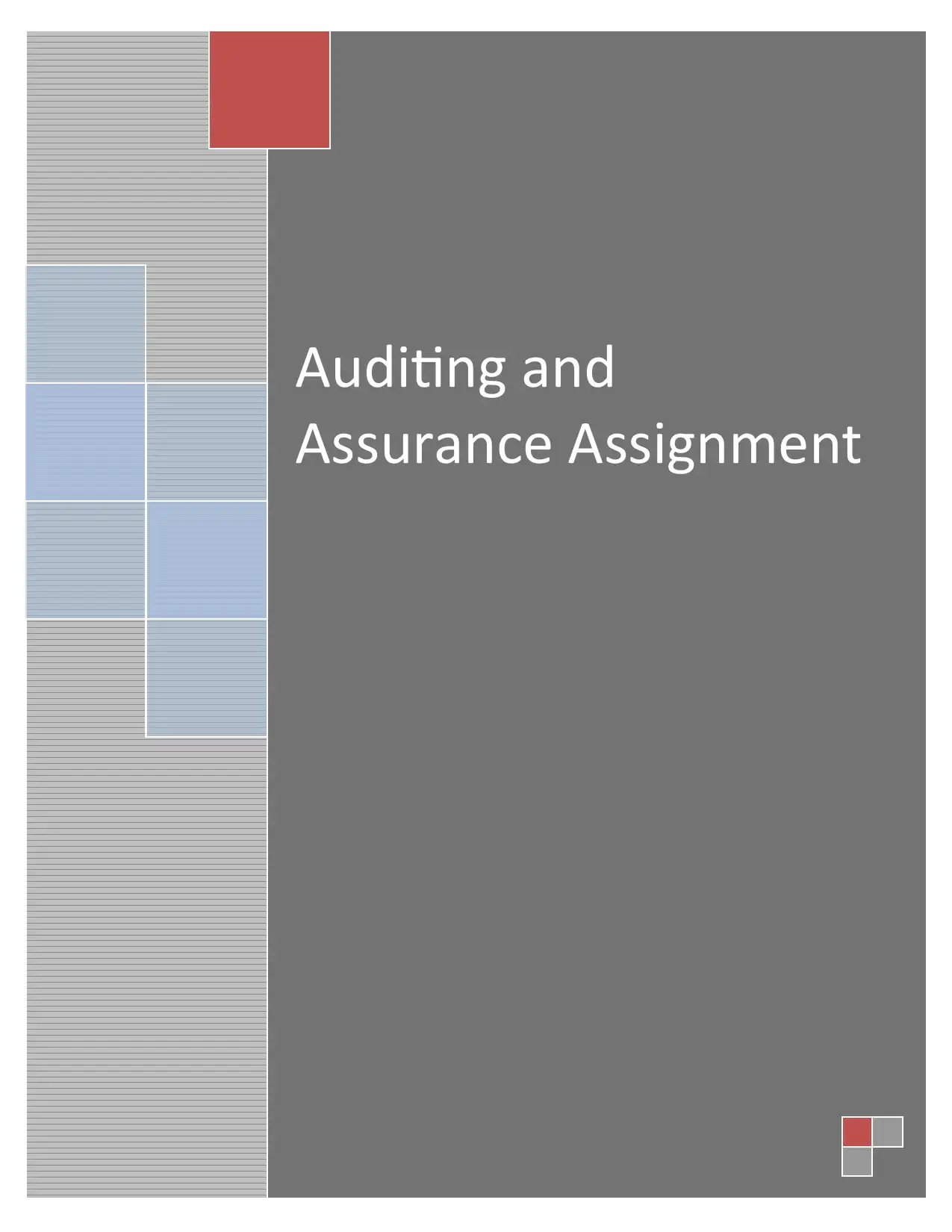
Auditing and
Assurance Assignment
Assurance Assignment
Paraphrase This Document
Need a fresh take? Get an instant paraphrase of this document with our AI Paraphraser
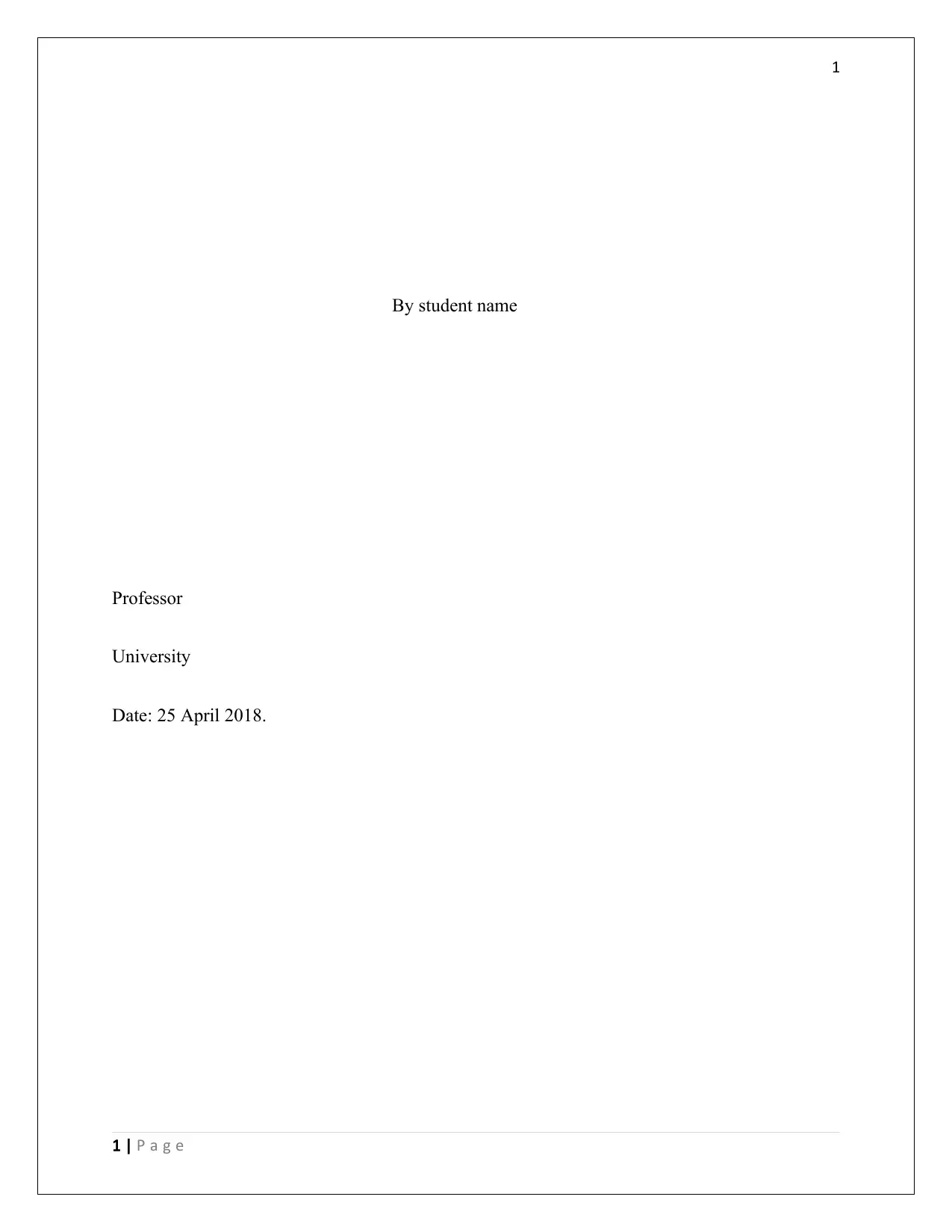
1
By student name
Professor
University
Date: 25 April 2018.
1 | P a g e
By student name
Professor
University
Date: 25 April 2018.
1 | P a g e
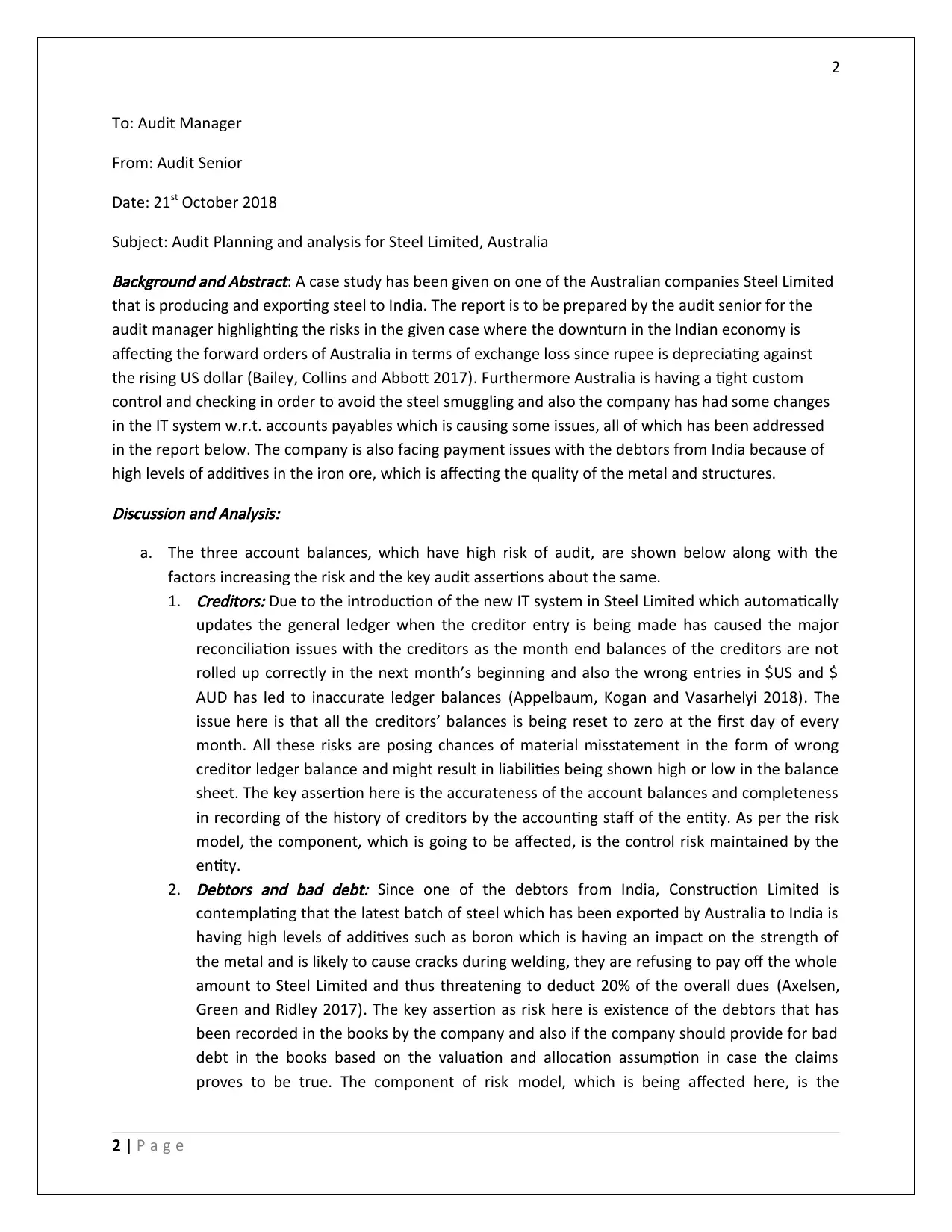
2
To: Audit Manager
From: Audit Senior
Date: 21st October 2018
Subject: Audit Planning and analysis for Steel Limited, Australia
Background and Abstract: A case study has been given on one of the Australian companies Steel Limited
that is producing and exporting steel to India. The report is to be prepared by the audit senior for the
audit manager highlighting the risks in the given case where the downturn in the Indian economy is
affecting the forward orders of Australia in terms of exchange loss since rupee is depreciating against
the rising US dollar (Bailey, Collins and Abbott 2017). Furthermore Australia is having a tight custom
control and checking in order to avoid the steel smuggling and also the company has had some changes
in the IT system w.r.t. accounts payables which is causing some issues, all of which has been addressed
in the report below. The company is also facing payment issues with the debtors from India because of
high levels of additives in the iron ore, which is affecting the quality of the metal and structures.
Discussion and Analysis:
a. The three account balances, which have high risk of audit, are shown below along with the
factors increasing the risk and the key audit assertions about the same.
1.
Creditors: Due to the introduction of the new IT system in Steel Limited which automatically
updates the general ledger when the creditor entry is being made has caused the major
reconciliation issues with the creditors as the month end balances of the creditors are not
rolled up correctly in the next month’s beginning and also the wrong entries in $US and $
AUD has led to inaccurate ledger balances (Appelbaum, Kogan and Vasarhelyi 2018). The
issue here is that all the creditors’ balances is being reset to zero at the first day of every
month. All these risks are posing chances of material misstatement in the form of wrong
creditor ledger balance and might result in liabilities being shown high or low in the balance
sheet. The key assertion here is the accurateness of the account balances and completeness
in recording of the history of creditors by the accounting staff of the entity. As per the risk
model, the component, which is going to be affected, is the control risk maintained by the
entity.
2.
Debtors and bad debt: Since one of the debtors from India, Construction Limited is
contemplating that the latest batch of steel which has been exported by Australia to India is
having high levels of additives such as boron which is having an impact on the strength of
the metal and is likely to cause cracks during welding, they are refusing to pay off the whole
amount to Steel Limited and thus threatening to deduct 20% of the overall dues (Axelsen,
Green and Ridley 2017). The key assertion as risk here is existence of the debtors that has
been recorded in the books by the company and also if the company should provide for bad
debt in the books based on the valuation and allocation assumption in case the claims
proves to be true. The component of risk model, which is being affected here, is the
2 | P a g e
To: Audit Manager
From: Audit Senior
Date: 21st October 2018
Subject: Audit Planning and analysis for Steel Limited, Australia
Background and Abstract: A case study has been given on one of the Australian companies Steel Limited
that is producing and exporting steel to India. The report is to be prepared by the audit senior for the
audit manager highlighting the risks in the given case where the downturn in the Indian economy is
affecting the forward orders of Australia in terms of exchange loss since rupee is depreciating against
the rising US dollar (Bailey, Collins and Abbott 2017). Furthermore Australia is having a tight custom
control and checking in order to avoid the steel smuggling and also the company has had some changes
in the IT system w.r.t. accounts payables which is causing some issues, all of which has been addressed
in the report below. The company is also facing payment issues with the debtors from India because of
high levels of additives in the iron ore, which is affecting the quality of the metal and structures.
Discussion and Analysis:
a. The three account balances, which have high risk of audit, are shown below along with the
factors increasing the risk and the key audit assertions about the same.
1.
Creditors: Due to the introduction of the new IT system in Steel Limited which automatically
updates the general ledger when the creditor entry is being made has caused the major
reconciliation issues with the creditors as the month end balances of the creditors are not
rolled up correctly in the next month’s beginning and also the wrong entries in $US and $
AUD has led to inaccurate ledger balances (Appelbaum, Kogan and Vasarhelyi 2018). The
issue here is that all the creditors’ balances is being reset to zero at the first day of every
month. All these risks are posing chances of material misstatement in the form of wrong
creditor ledger balance and might result in liabilities being shown high or low in the balance
sheet. The key assertion here is the accurateness of the account balances and completeness
in recording of the history of creditors by the accounting staff of the entity. As per the risk
model, the component, which is going to be affected, is the control risk maintained by the
entity.
2.
Debtors and bad debt: Since one of the debtors from India, Construction Limited is
contemplating that the latest batch of steel which has been exported by Australia to India is
having high levels of additives such as boron which is having an impact on the strength of
the metal and is likely to cause cracks during welding, they are refusing to pay off the whole
amount to Steel Limited and thus threatening to deduct 20% of the overall dues (Axelsen,
Green and Ridley 2017). The key assertion as risk here is existence of the debtors that has
been recorded in the books by the company and also if the company should provide for bad
debt in the books based on the valuation and allocation assumption in case the claims
proves to be true. The component of risk model, which is being affected here, is the
2 | P a g e
⊘ This is a preview!⊘
Do you want full access?
Subscribe today to unlock all pages.

Trusted by 1+ million students worldwide
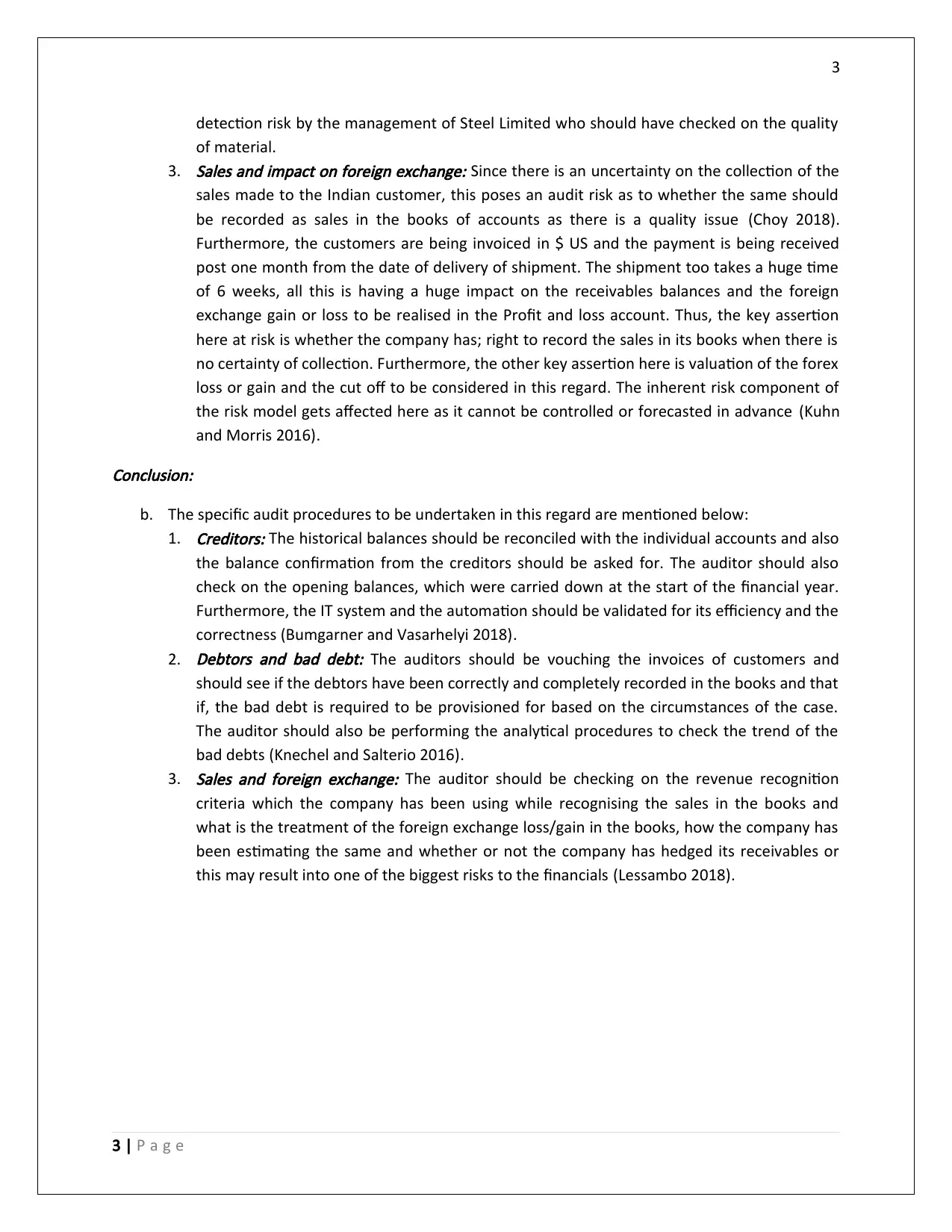
3
detection risk by the management of Steel Limited who should have checked on the quality
of material.
3.
Sales and impact on foreign exchange: Since there is an uncertainty on the collection of the
sales made to the Indian customer, this poses an audit risk as to whether the same should
be recorded as sales in the books of accounts as there is a quality issue (Choy 2018).
Furthermore, the customers are being invoiced in $ US and the payment is being received
post one month from the date of delivery of shipment. The shipment too takes a huge time
of 6 weeks, all this is having a huge impact on the receivables balances and the foreign
exchange gain or loss to be realised in the Profit and loss account. Thus, the key assertion
here at risk is whether the company has; right to record the sales in its books when there is
no certainty of collection. Furthermore, the other key assertion here is valuation of the forex
loss or gain and the cut off to be considered in this regard. The inherent risk component of
the risk model gets affected here as it cannot be controlled or forecasted in advance (Kuhn
and Morris 2016).
Conclusion:
b. The specific audit procedures to be undertaken in this regard are mentioned below:
1.
Creditors: The historical balances should be reconciled with the individual accounts and also
the balance confirmation from the creditors should be asked for. The auditor should also
check on the opening balances, which were carried down at the start of the financial year.
Furthermore, the IT system and the automation should be validated for its efficiency and the
correctness (Bumgarner and Vasarhelyi 2018).
2.
Debtors and bad debt: The auditors should be vouching the invoices of customers and
should see if the debtors have been correctly and completely recorded in the books and that
if, the bad debt is required to be provisioned for based on the circumstances of the case.
The auditor should also be performing the analytical procedures to check the trend of the
bad debts (Knechel and Salterio 2016).
3.
Sales and foreign exchange: The auditor should be checking on the revenue recognition
criteria which the company has been using while recognising the sales in the books and
what is the treatment of the foreign exchange loss/gain in the books, how the company has
been estimating the same and whether or not the company has hedged its receivables or
this may result into one of the biggest risks to the financials (Lessambo 2018).
3 | P a g e
detection risk by the management of Steel Limited who should have checked on the quality
of material.
3.
Sales and impact on foreign exchange: Since there is an uncertainty on the collection of the
sales made to the Indian customer, this poses an audit risk as to whether the same should
be recorded as sales in the books of accounts as there is a quality issue (Choy 2018).
Furthermore, the customers are being invoiced in $ US and the payment is being received
post one month from the date of delivery of shipment. The shipment too takes a huge time
of 6 weeks, all this is having a huge impact on the receivables balances and the foreign
exchange gain or loss to be realised in the Profit and loss account. Thus, the key assertion
here at risk is whether the company has; right to record the sales in its books when there is
no certainty of collection. Furthermore, the other key assertion here is valuation of the forex
loss or gain and the cut off to be considered in this regard. The inherent risk component of
the risk model gets affected here as it cannot be controlled or forecasted in advance (Kuhn
and Morris 2016).
Conclusion:
b. The specific audit procedures to be undertaken in this regard are mentioned below:
1.
Creditors: The historical balances should be reconciled with the individual accounts and also
the balance confirmation from the creditors should be asked for. The auditor should also
check on the opening balances, which were carried down at the start of the financial year.
Furthermore, the IT system and the automation should be validated for its efficiency and the
correctness (Bumgarner and Vasarhelyi 2018).
2.
Debtors and bad debt: The auditors should be vouching the invoices of customers and
should see if the debtors have been correctly and completely recorded in the books and that
if, the bad debt is required to be provisioned for based on the circumstances of the case.
The auditor should also be performing the analytical procedures to check the trend of the
bad debts (Knechel and Salterio 2016).
3.
Sales and foreign exchange: The auditor should be checking on the revenue recognition
criteria which the company has been using while recognising the sales in the books and
what is the treatment of the foreign exchange loss/gain in the books, how the company has
been estimating the same and whether or not the company has hedged its receivables or
this may result into one of the biggest risks to the financials (Lessambo 2018).
3 | P a g e
Paraphrase This Document
Need a fresh take? Get an instant paraphrase of this document with our AI Paraphraser
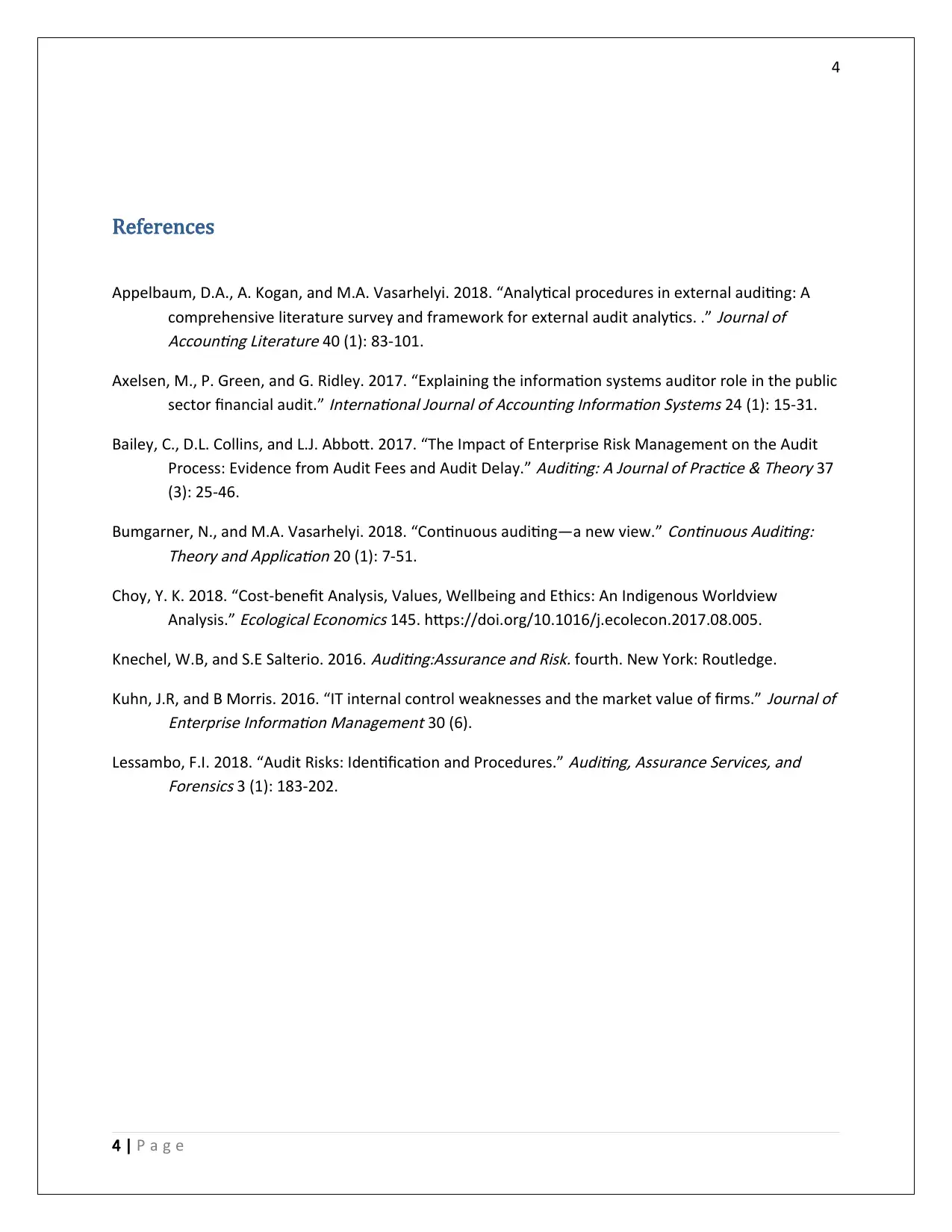
4
References
Appelbaum, D.A., A. Kogan, and M.A. Vasarhelyi. 2018. “Analytical procedures in external auditing: A
comprehensive literature survey and framework for external audit analytics. .”
Journal of
Accounting Literature 40 (1): 83-101.
Axelsen, M., P. Green, and G. Ridley. 2017. “Explaining the information systems auditor role in the public
sector financial audit.”
International Journal of Accounting Information Systems 24 (1): 15-31.
Bailey, C., D.L. Collins, and L.J. Abbott. 2017. “The Impact of Enterprise Risk Management on the Audit
Process: Evidence from Audit Fees and Audit Delay.”
Auditing: A Journal of Practice & Theory 37
(3): 25-46.
Bumgarner, N., and M.A. Vasarhelyi. 2018. “Continuous auditing—a new view.”
Continuous Auditing:
Theory and Application 20 (1): 7-51.
Choy, Y. K. 2018. “Cost-benefit Analysis, Values, Wellbeing and Ethics: An Indigenous Worldview
Analysis.”
Ecological Economics 145. https://doi.org/10.1016/j.ecolecon.2017.08.005.
Knechel, W.B, and S.E Salterio. 2016.
Auditing:Assurance and Risk. fourth. New York: Routledge.
Kuhn, J.R, and B Morris. 2016. “IT internal control weaknesses and the market value of firms.”
Journal of
Enterprise Information Management 30 (6).
Lessambo, F.I. 2018. “Audit Risks: Identification and Procedures.”
Auditing, Assurance Services, and
Forensics 3 (1): 183-202.
4 | P a g e
References
Appelbaum, D.A., A. Kogan, and M.A. Vasarhelyi. 2018. “Analytical procedures in external auditing: A
comprehensive literature survey and framework for external audit analytics. .”
Journal of
Accounting Literature 40 (1): 83-101.
Axelsen, M., P. Green, and G. Ridley. 2017. “Explaining the information systems auditor role in the public
sector financial audit.”
International Journal of Accounting Information Systems 24 (1): 15-31.
Bailey, C., D.L. Collins, and L.J. Abbott. 2017. “The Impact of Enterprise Risk Management on the Audit
Process: Evidence from Audit Fees and Audit Delay.”
Auditing: A Journal of Practice & Theory 37
(3): 25-46.
Bumgarner, N., and M.A. Vasarhelyi. 2018. “Continuous auditing—a new view.”
Continuous Auditing:
Theory and Application 20 (1): 7-51.
Choy, Y. K. 2018. “Cost-benefit Analysis, Values, Wellbeing and Ethics: An Indigenous Worldview
Analysis.”
Ecological Economics 145. https://doi.org/10.1016/j.ecolecon.2017.08.005.
Knechel, W.B, and S.E Salterio. 2016.
Auditing:Assurance and Risk. fourth. New York: Routledge.
Kuhn, J.R, and B Morris. 2016. “IT internal control weaknesses and the market value of firms.”
Journal of
Enterprise Information Management 30 (6).
Lessambo, F.I. 2018. “Audit Risks: Identification and Procedures.”
Auditing, Assurance Services, and
Forensics 3 (1): 183-202.
4 | P a g e
1 out of 5
Related Documents
Your All-in-One AI-Powered Toolkit for Academic Success.
+13062052269
info@desklib.com
Available 24*7 on WhatsApp / Email
![[object Object]](/_next/static/media/star-bottom.7253800d.svg)
Unlock your academic potential
Copyright © 2020–2025 A2Z Services. All Rights Reserved. Developed and managed by ZUCOL.





